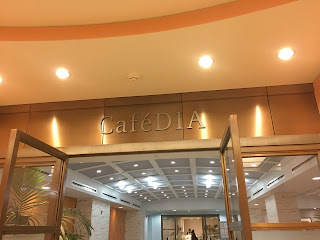Can you imagine beginning your day without a hot cup of tea? I can't, but history proves it wasn't always readily available. The exhibit retraced coffee, tea, hot chocolate, and sugar's arrival in Europe during the late sixteenth century [1500's], and its growth into the eighteenth century along with exquisite equipage/decorative arts.
~ A 1777-78 Silver Tea Urn was displayed as we entered the exhibit hall. ~
Coffee, Tea, and Hot Chocolate stimulated the senses in ways Europeans had never before experienced, and this fascination required new, specialized vessels - coffeepots, tea sets, and chocolate pots and cups. The exhibit began with coffee, and while I looked at all the displays and read the explanations, I didn't take photos until I entered the tea exhibit. I took 126 pictures, but I promise they won't all be in this post! ;-)
I purchased the book that accompanies the exhibit and found the following statistic very interesting: Over the course of the eighteenth century the consumption of tea grew from 1 million to 40 million pounds, but coffee was more predominant.
Dates vary slightly from author to author, but the D.I.A. book I purchased said tea [along with other expensive items like spices, silks, and porcelain] came to Europe in 1610 via the Dutch East India Co. - Amsterdam, on ships similar to those pictured below.
At the beginning of the eighteenth century, the British embraced tea like no other European nation. England's fondness for tea is attributed to Portuguese Princess, Catharine of Braganza, who married British King, Charles II in 1662. Her dowry included a chest of tea, which became popular at Court, and among Britain's upper class.
~ The Strong family in Britain, 1732, enjoying Afternoon Tea. ~
~ 1740-48 Silver Kettle and Stand ~
1804 Tea and Coffee [hard-paste porcelain] Service - Vienna Porcelain Manufactory, Austria.
~ 1760 24- piece Tea and Coffee Service, Fustenberg Porcelain Factory, Germany ~
[Landscape scenes of shepherds tending flocks.]
Far left is a 1789 Silver Tea Caddy and a tea service by Royal Worcester [one of the first porcelain factories established in England].
1728-29 Tea Service with Fitted Case
Left -1700's Red Stoneware Teapot; Middle- Wine Cup; Right - 1720 Cup and Saucer from Saint-Cloud Porcelain Manufactory, France.
1842-43 Tea and Coffee Service, Sevres Porcelain Manufactory, France
1723-24 Meissen Teapot, Germany, and 1750-56 Tortoiseshell, Silver, and Wood Tea Caddy
To offset the bitterness of coffee, tea, and chocolate, Europeans established the custom of adding sugar and milk to their hot beverages. Sugarcane couldn't be grown in the European climate, so they established plantations in their colonies in the Americas using African slaves to produce it.
~ 1678 silver sugar bowl and 1770 Royal Worcester covered sugar bowl. ~
Essential 'tools' for hot beverages - 1750 silver teaspoons and sugar nippers and 1764 silver hot milk pot. In the 1700's sugar was sold in loaves and broken into chunks. Sugar nippers were used to pick up the chunks/pieces. The teaspoon was an indispensable utensil on the tea table for stirring milk and sugar into tea, and it became a standardized unit of measurement.
The 1800 'traveling box with cup and saucer' from Spain was very interesting, and something I've never seen before.
~ 1728-29 Meissen Breakfast Set with velvet lined chest. ~
Even though chocolate was the first of the three commodities to arrive in Europe, it was featured last in the exhibit. Below is a cocoa pod. Inside are cocoa beans that are fermented, dried, roasted, and ground. In the gift shop we were able to see cocoa beans which resembled almonds in size and appearance.
Below a pair of 1760 Meissen cups and saucers for drinking hot chocolate.
A video showed a chef making hot chocolate, and demonstrating that chocolate pots [visible in lower right hand corner] had an opening in the lid where a stick-like stirring utensil could be inserted and twirled back and forth to stir the beverage. Later when Europeans began to prefer chocolate bars over hot chocolate the openings were sealed and the pots were repurposed for serving coffee.
~ At the end of the exhibit was a chocolate tasting. ~
My friend and I agreed, the 18th Century French Recipe was much better than the ancient, bitter Aztec recipe.
Students who came to the exhibit on a school field trip wrote short notes about how the exhibit will affect their future tasting experiences of coffee, tea, or chocolate and they were posted at the end of the exhibit hall [pictured below].
I loved one student's artistic response [below]. As they say, a picture is worth a thousand words!
~ One of the displays in the gift shop. ~
I bought a limited, commemorative tin of tea especially blended by Eli Tea in Birmingham, MI for the exhibit. A separate post will be written about Eli Tea soon.
Then we were off to D.I.A.'s Café for lunch.
There were so many offerings, but I opted for a cup of clam chowder, cheese biscuit, salad from the self-serve bar [charged by the ounce], and a cup of Tazo Chai tea. Everything was yummy!
Even though this is a lengthy post, it is only a small sampling of the entire exhibit. Make a day of it and go see the D.I.A. exhibit. Tickets are only $10 for tri-county residents [plus $7 for parking in the D.I.A. secured lot]. The exhibit will be there thru March 5th. You'll be glad you went!
































Oh, all those beautiful teawares! I'd love to see this exhibit, but since I'm pretty far away, I'll be content to enjoy it through your pictures.
ReplyDelete